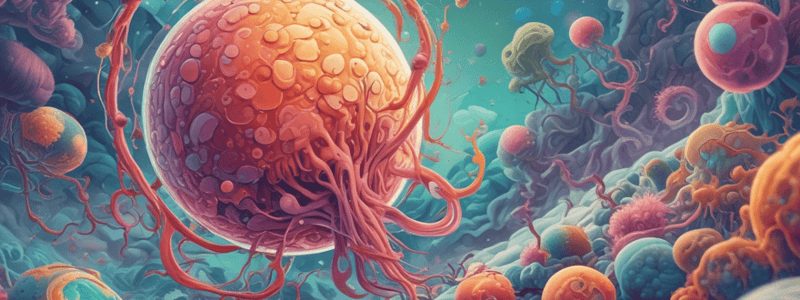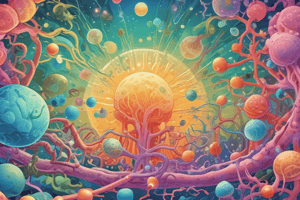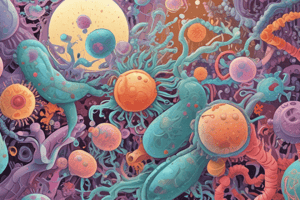Podcast
Questions and Answers
What characteristic do bacteria lack?
What characteristic do bacteria lack?
- Ribosomes
- Flagella
- Cell wall
- Membranous organelles (correct)
What is unique about the growth rate of bacteria?
What is unique about the growth rate of bacteria?
- Bacteria do not grow at all
- All bacteria grow rapidly
- Some bacteria grow rapidly, while others grow slowly (correct)
- All bacteria grow slowly
What is a characteristic of opportunistic pathogens?
What is a characteristic of opportunistic pathogens?
- They cause disease under usual conditions
- They never cause disease
- They cause disease only in immunocompromised individuals (correct)
- They always cause disease
What is a characteristic of commensal bacteria?
What is a characteristic of commensal bacteria?
Who is credited with the discovery of microorganisms?
Who is credited with the discovery of microorganisms?
What is the main difference between true pathogens and opportunistic pathogens?
What is the main difference between true pathogens and opportunistic pathogens?
What is the function of ribosomes in bacterial cells?
What is the function of ribosomes in bacterial cells?
What are the two main subunits of ribosomes?
What are the two main subunits of ribosomes?
What is the role of the genetic code in ribosomes?
What is the role of the genetic code in ribosomes?
What are the two main applications of ribosomes?
What are the two main applications of ribosomes?
What is the layer outside the cytoplasmic membrane in a bacterial cell?
What is the layer outside the cytoplasmic membrane in a bacterial cell?
What is the function of the bacterial envelope?
What is the function of the bacterial envelope?
What is the primary component of the bacterial cell wall?
What is the primary component of the bacterial cell wall?
What is the function of membrane-associated proteins in the bacterial envelope?
What is the function of membrane-associated proteins in the bacterial envelope?
What is the target of some antibiotics, according to Poehlsgaard and Douthwaite?
What is the target of some antibiotics, according to Poehlsgaard and Douthwaite?
What is the main characteristic that distinguishes prokaryotes from eukaryotes?
What is the main characteristic that distinguishes prokaryotes from eukaryotes?
Which of the following structures is present in all bacteria?
Which of the following structures is present in all bacteria?
What is the function of the cytoplasm in a bacterial cell?
What is the function of the cytoplasm in a bacterial cell?
What is the exception to the complex and rigid cell wall in bacteria?
What is the exception to the complex and rigid cell wall in bacteria?
What is the term for the region where the DNA is located in a bacterial cell?
What is the term for the region where the DNA is located in a bacterial cell?
What are the three main components of the cytoplasm in a bacterial cell?
What are the three main components of the cytoplasm in a bacterial cell?
What is the function of the plasma membrane in a bacterial cell?
What is the function of the plasma membrane in a bacterial cell?
What is the term for the protective layer outside the plasma membrane in some bacteria?
What is the term for the protective layer outside the plasma membrane in some bacteria?
What is the term for the dormant, highly resistant structure that some bacteria can form?
What is the term for the dormant, highly resistant structure that some bacteria can form?
What is the primary function of flagella in bacteria?
What is the primary function of flagella in bacteria?
What is the main function of pili/fimbriae in bacteria?
What is the main function of pili/fimbriae in bacteria?
Which type of bacteria produce endospores?
Which type of bacteria produce endospores?
What is the purpose of endospores?
What is the purpose of endospores?
What is the result of spore germination?
What is the result of spore germination?
What is the characteristic of endospores?
What is the characteristic of endospores?
What is the function of flagella in relation to bacterial movement?
What is the function of flagella in relation to bacterial movement?
What is the characteristic of pili/fimbriae?
What is the characteristic of pili/fimbriae?
What is the purpose of bacterial toxins synthesized by vegetative bacilli?
What is the purpose of bacterial toxins synthesized by vegetative bacilli?
What is the origin of a bacterial colony in solid media?
What is the origin of a bacterial colony in solid media?
What is the term for a single bacterium that can give rise to a colony?
What is the term for a single bacterium that can give rise to a colony?
What can affect the morphology of a bacterial colony?
What can affect the morphology of a bacterial colony?
What is the process by which bacteria replicate?
What is the process by which bacteria replicate?
What is an essential environmental factor required for bacterial growth?
What is an essential environmental factor required for bacterial growth?
What is the optimal pH range for most pathogenic bacteria?
What is the optimal pH range for most pathogenic bacteria?
What can cause different colony morphologies in the same bacterial species?
What can cause different colony morphologies in the same bacterial species?
What is a characteristic of bacterial growth?
What is a characteristic of bacterial growth?
What determines the shape of a bacterial colony?
What determines the shape of a bacterial colony?
Flashcards
Bacteria
Bacteria
Unicellular organisms lacking membranous organelles and a true nucleus.
True pathogens
True pathogens
Organisms that cause disease in healthy individuals.
Opportunistic pathogens
Opportunistic pathogens
Organisms that cause disease in weakened individuals.
Commensal bacteria
Commensal bacteria
Signup and view all the flashcards
Cytoplasm
Cytoplasm
Signup and view all the flashcards
Ribosomes
Ribosomes
Signup and view all the flashcards
Bacterial Envelope
Bacterial Envelope
Signup and view all the flashcards
Flagella
Flagella
Signup and view all the flashcards
Pili/Fimbriae
Pili/Fimbriae
Signup and view all the flashcards
Endospores
Endospores
Signup and view all the flashcards
Bacterial colony
Bacterial colony
Signup and view all the flashcards
Binary Fission
Binary Fission
Signup and view all the flashcards
Study Notes
Bacteriology Overview
- Bacteria are unicellular organisms that lack membranous organelles and a true nucleus.
- They are small in size, large in number, and have evolved to survive in various ecological niches.
- Some bacteria grow rapidly, while others grow slowly, and they require minimal to fastidious nutrients to grow.
Bacteria in Numbers
- There are approximately 1.3 x 10^29 bacteria in oceans, which is 100 million times more cells than stars in the visible universe.
- There are more microbes in a teaspoon of soil than there are people on earth.
- Human adults excrete their own weight in fecal bacteria every year.
- There are approximately 1 x 10^11 bacteria in 1g of dental plaque, which is the same number as humans who have ever lived.
- Approximately 16,000,000 people worldwide die from infectious diseases every year.
Types of Bacteria
- Bacteria can be true pathogens, opportunistic pathogens, or commensals.
- True pathogens can cause disease in healthy immunocompetent individuals.
- Opportunistic pathogens are organisms that usually do not cause disease but can induce an infectious process in weakened individuals.
- Commensal bacteria reside on the surface or internal mucosae of the host without harming it, often forming a mutualistic relationship.
Bacterial Cell Structure
- Prokaryotes lack membranous organelles and have a unicellular structure.
- All bacteria have cytoplasm, ribosomes, a nucleoid (DNA), a plasma membrane, and a complex and rigid cell wall (except for one exception).
- Some bacteria have additional features such as capsules, flagella, pili/fimbriae, and plasmids, and some can produce endospores.
Cytoplasm
- Cytoplasm is a jelly-like aqueous solution (cytosol) containing three main components: macromolecules (proteins, mRNA, tRNA), small molecules (precursors of macromolecules, metabolites, ATP, etc.), and bacterial cell structures.
Ribosomes
- Ribosomes are the cellular protein factory, composed of proteins and rRNA.
- They consist of two subunits: large (50S) and small (30S).
- Ribosomes have a conserved genetic code and are used in therapy and phylogeny.
Bacterial Envelope
- The bacterial envelope consists of the cytoplasmic or plasma membrane, membrane-associated proteins, a cell wall (peptidoglycan layer), and other components.
Flagella
- Flagella are anchored to the bacterial cell envelope, are multi-protein structures, and have varying numbers and positions between bacteria.
- They function in locomotion or bacterial motility.
Pili/Fimbriae
- Pili/fimbriae are fine, straight, hair-like appendages attached to the cell wall, known as "adhesins".
- They are most common on Gram-negative bacteria and function in adhesion to host tissues and contributing to antigenicity.
Endospores
- Endospores are the cryptobiotic state of dormancy, the most durable type of cell found in nature, and are produced by Gram-positive bacteria.
- They function in ensuring survival during adverse environmental conditions and are dormant, highly resistant bodies.
Bacterial Cell and Colony Morphology
- A bacterial colony is a macroscopic aggregate of bacteria in solid media, originated from a single bacterium, and is theoretically a Colony Forming Unit (CFU) = 1 bacterium.
- Colonies may look different during time and depending on the growth medium used.
Bacterial Growth and Metabolism
- Bacterial growth occurs through binary fission, where one mother cell results in two daughter cells.
- Specific environmental factors are required for bacterial growth, including nutrients, pH, ionic strength and osmotic pressure, and light.
Studying That Suits You
Use AI to generate personalized quizzes and flashcards to suit your learning preferences.




